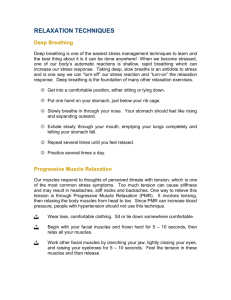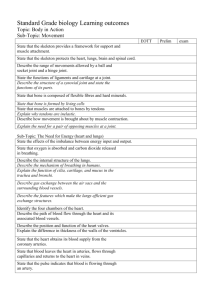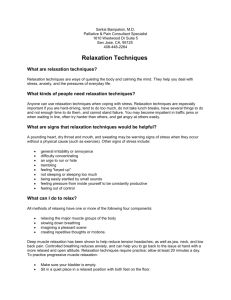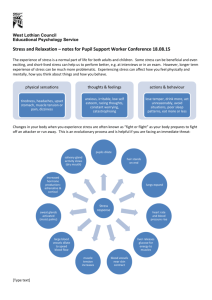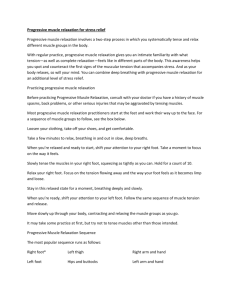Stress Mgmt Handout - Dr. Andy Case
advertisement
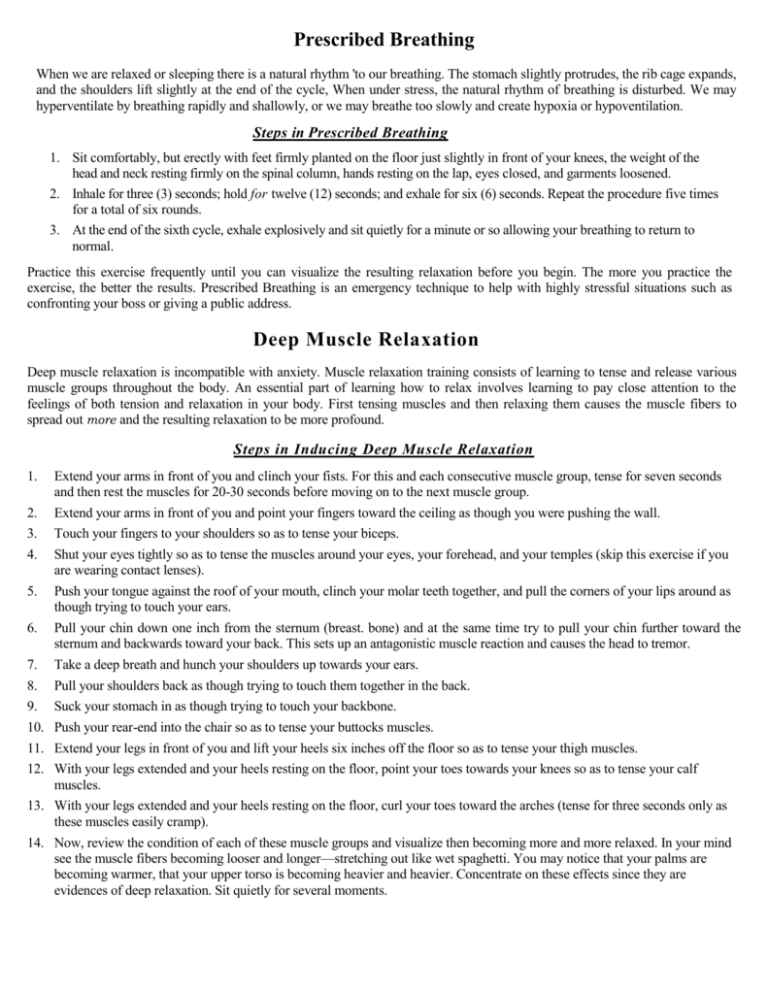
Prescribed Breathing When we are relaxed or sleeping there is a natural rhythm 'to our breathing. The stomach slightly protrudes, the rib cage expands, and the shoulders lift slightly at the end of the cycle, When under stress, the natural rhythm of breathing is disturbed. We may hyperventilate by breathing rapidly and shallowly, or we may breathe too slowly and create hypoxia or hypoventilation. Steps in Prescribed Breathing 1. Sit comfortably, but erectly with feet firmly planted on the floor just slightly in front of your knees, the weight of the head and neck resting firmly on the spinal column, hands resting on the lap, eyes closed, and garments loosened. 2. Inhale for three (3) seconds; hold for twelve (12) seconds; and exhale for six (6) seconds. Repeat the procedure five times for a total of six rounds. 3. At the end of the sixth cycle, exhale explosively and sit quietly for a minute or so allowing your breathing to return to normal. Practice this exercise frequently until you can visualize the resulting relaxation before you begin. The more you practice the exercise, the better the results. Prescribed Breathing is an emergency technique to help with highly stressful situations such as confronting your boss or giving a public address. Deep Muscle Relaxation Deep muscle relaxation is incompatible with anxiety. Muscle relaxation training consists of learning to tense and release various muscle groups throughout the body. An essential part of learning how to relax involves learning to pay close attention to the feelings of both tension and relaxation in your body. First tensing muscles and then relaxing them causes the muscle fibers to spread out more and the resulting relaxation to be more profound. Steps in Inducing Deep Muscle Relaxation 1. Extend your arms in front of you and clinch your fists. For this and each consecutive muscle group, tense for seven seconds and then rest the muscles for 20-30 seconds before moving on to the next muscle group. 2. Extend your arms in front of you and point your fingers toward the ceiling as though you were pushing the wall. 3. Touch your fingers to your shoulders so as to tense your biceps. 4. Shut your eyes tightly so as to tense the muscles around your eyes, your forehead, and your temples (skip this exercise if you are wearing contact lenses). 5. Push your tongue against the roof of your mouth, clinch your molar teeth together, and pull the corners of your lips around as though trying to touch your ears. Pull your chin down one inch from the sternum (breast. bone) and at the same time try to pull your chin further toward the sternum and backwards toward your back. This sets up an antagonistic muscle reaction and causes the head to tremor. 6. 7. 8. Take a deep breath and hunch your shoulders up towards your ears. Pull your shoulders back as though trying to touch them together in the back. 9. Suck your stomach in as though trying to touch your backbone. 10. Push your rear-end into the chair so as to tense your buttocks muscles. 11. Extend your legs in front of you and lift your heels six inches off the floor so as to tense your thigh muscles. 12. With your legs extended and your heels resting on the floor, point your toes towards your knees so as to tense your calf muscles. 13. With your legs extended and your heels resting on the floor, curl your toes toward the arches (tense for three seconds only as these muscles easily cramp). 14. Now, review the condition of each of these muscle groups and visualize then becoming more and more relaxed. In your mind see the muscle fibers becoming looser and longer—stretching out like wet spaghetti. You may notice that your palms are becoming warmer, that your upper torso is becoming heavier and heavier. Concentrate on these effects since they are evidences of deep relaxation. Sit quietly for several moments.
